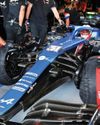
The Rush SR-1 is the brainchild of mechanical engineer David Hosie, who originally harks from Scotland. Having completed his engineering degree in Aberdeen the oil and gas industry was the natural place for him to hone his skills, and this explains why he now resides in Houston.
Hosie serves on the board of directors of an oil and gas company but, parallel to his career in this industry he’s been heavily involved in racing for quite some time. ‘I’ve always been in motorsport for one reason or another, be it karting to running a five-car Formula Renault team [known as Fran Am 2000] for three years here in the US,’ says Hosie.
Working in junior open-wheel series brought Hosie into contact with many young racing hopefuls and their families and he started to notice the darker side of the motorsport progression ladder. ‘Running a junior formula team, you are basically a service company,’ he says. ‘Your customer is between the age of 16 to 22 and has access to half a million of Dad’s money to pursue their dream of becoming a racing driver. In the years I was involved, I saw that destroy families.’ he says.
Racing has never been cheap, but the current ladder system to becoming a top-level driver – karting and then through various single-seater championships – is very far from being affordable. While Hosie admires efforts such as that of the FIA F4 series, with cost caps keeping things under control, he still feels that ‘it hasn’t worked. An arrive and drive package with a decent team will still be $300,000.’
Ready market
This story is from the March 2020 edition of Racecar Engineering.
Start your 7-day Magzter GOLD free trial to access thousands of curated premium stories, and 8,500+ magazines and newspapers.
Already a subscriber ? Sign In
This story is from the March 2020 edition of Racecar Engineering.
Start your 7-day Magzter GOLD free trial to access thousands of curated premium stories, and 8,500+ magazines and newspapers.
Already a subscriber? Sign In
Talk the torque
More thoughts on in-wheel motors and their effects on twisting force
Rolling about
An explanation of the limitations of a previous load transfer article, bringing jacking forces into the mix
F1 breaks schedule records
The FIA has confirmed no fewer than 23 races on the 2022 Formula 1 World Championship schedule, the highest number of grands prix ever to be held in a single season, and that has led to criticism from some teams that will be on the road for eight months.

Under pressure
Toyota may have finished first and second at Le Mans this year, but the effort required to overcome a fuel delivery problem and finish with both cars was Herculean
Physics at work
Dutch company, Intrax, offers Racecar Engineering an insight into the technologies it employs to optimise its suspension products
Williams' 2030 ambition
Williams Racing has committed to becoming climate positive by 2030 as part of an all-new sustainability strategy.
Diff'rent strokes
Racecar looks at the different types of mechanical differential, their benefits and limitations
Das Boot
A curious Twitter exchange fired up a unique, hydrogen-powered, cross-country project that will contest the Baja 1000 in November 2022

Air born
Every racecar engineer's dream is a blank sheet of paper design. When Hoonigan and Subaru approached Vermont Sportscars about building the next generation of Gymkhana racer, that's just what the company was given

Remote control
Called variously ‘virtual garages’, ‘mission control’ or ‘race support rooms’ is the future of race engineering sitting in the warm back at HQ?